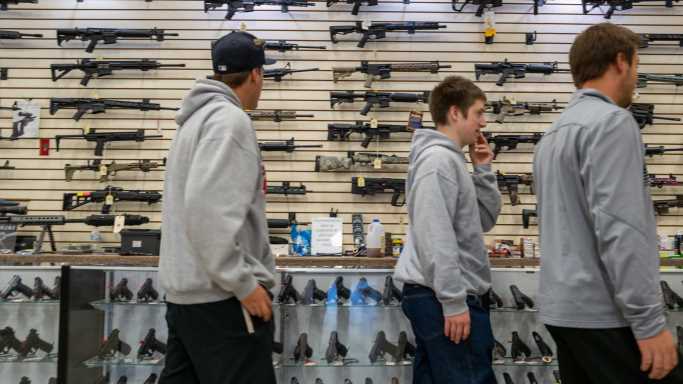After surging to exceptional levels in 2020 and 2021, U.S. demand for handguns, shotguns, and rifles began settling toward pre-pandemic levels in 2022. Now, government data suggests firearm sales have retreated in most states.
24/7 Wall St. used the FBI’s National Instant Criminal Background Check System to find the states where gun sales fell the most in June 2023 compared to June last year. The data shows that adjusted-firearm background checks declined in every state except for Utah, Connecticut, Maryland, and North Carolina, which recorded increases of between 5% and 15% in June compared to the same month last year. Firearm background checks serve as a commonly used proxy for U.S. gun sales, but they do not include all firearm transactions. We adjusted background checks by excluding categories that are not necessarily related to the sale of a gun, such as rechecks.
In sixteen states, adjusted-background checks fell by more than 20%, including in three of the country’s most populous states: New York, Florida, and Texas. In Delaware and Washington state, checks fell by more than half. In California, background checks in June declined by 9.2%, or 10,119, compared to the same month last year.
In all 50 states, the number of adjusted background checks declined by 18.6% in June 2023 compared to June 2022, while the number of background checks for every 1,000 residents was 4.2 in June – between 1.2 in Hawaii and 9.7 in Idaho. This was down from 5.2 per 1,000 residents in June 2022 – between 1.3 in Hawaii and 10.9 in Alabama.
Even after adjusting background checks, the data is far from complete and should be used only as a rough estimate for gun sales. There is no requirement that federally licensed dealers report sales volume to the Bureau of Alcohol, Tobacco, Firearms, and Explosives, and private gun transactions are exempt from background checks – commonly referred to as the “gun show loophole.” Also, regulations regarding background checks and their reporting vary by state.
Firearm-focused news site The Trace reported in March that according to an ATF report, 465 million guns have been produced for the U.S. non-military market since 1899 through 2020. A conservative estimate that accounts for guns that were broken, confiscated, or illegally exported therefore puts the total number of firearms in circulation at 352 million as of that year. (These are America’s largest gun makers.)
Other estimates are higher. The Firearm Industry Trade Association estimates the number of guns in circulation in the U.S. at 434 million, while the Small Arms Survey put it at nearly 400 million in 2017. Considering the surge in firearm purchases during the pandemic, the number of civilian firearms in circulation has no doubt increased, regardless of the estimate, fueled by demand for handguns. Handguns are the most common firearm used to commit violent crime, including multiple-victim homicides. (Here are America’s most popular 22 caliber handgun companies.)
Here is where gun sales declined in the United States.
Click here to see our detailed methodology.
Sponsored: Find a Qualified Financial Advisor
Finding a qualified financial advisor doesn’t have to be hard. SmartAsset’s free tool matches you with up to 3 fiduciary financial advisors in your area in 5 minutes. Each advisor has been vetted by SmartAsset and is held to a fiduciary standard to act in your best interests. If you’re ready to be matched with local advisors that can help you achieve your financial goals, get started now.
Source: Read Full Article
-
Demand for white-collar gig roles rises 11% YoY in March 2023: Foundit.in
-
UK Film And TV Set Designer 4Wood Acquired By Private Equity Company Amid South Wales Production Boom; ITV Commissions Psychological Thriller Platform 7 For New Streaming Platform – Global Briefs
-
FDA Approves Invitae's DNA Test To Assess Predisposition For Certain Cancers
-
Valuation comfort remains with PSU banks despite sharp gains
-
U.S. Stocks Close Modestly Higher Following Another Choppy Session

